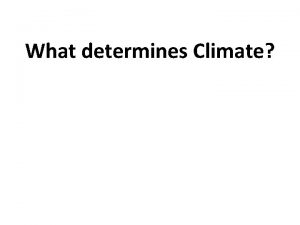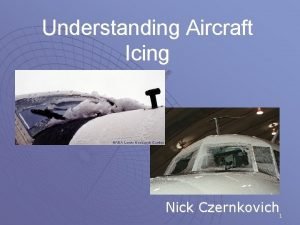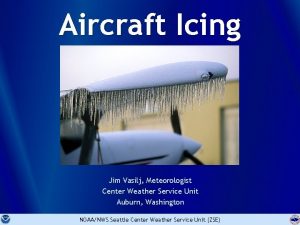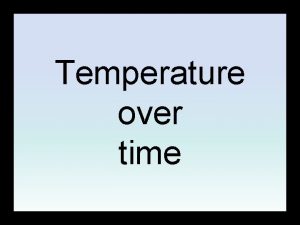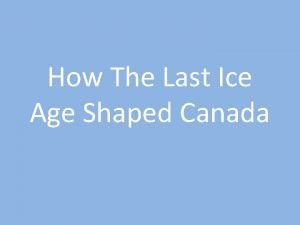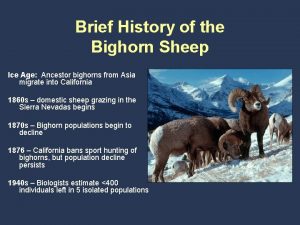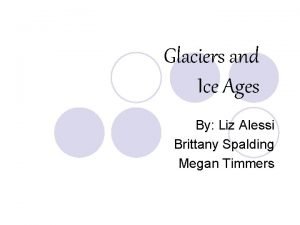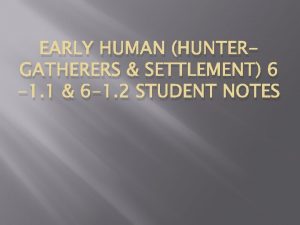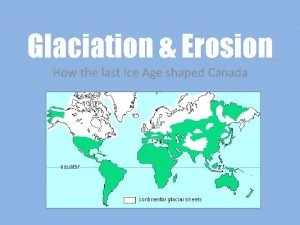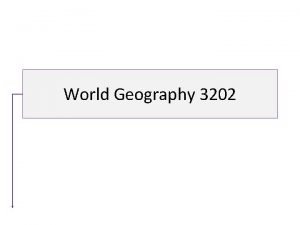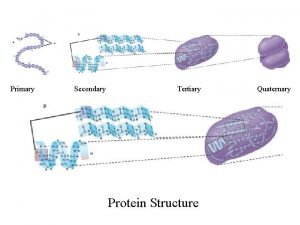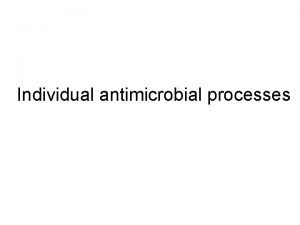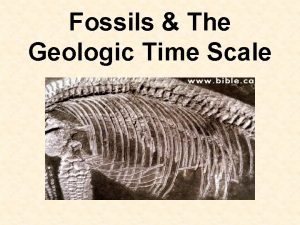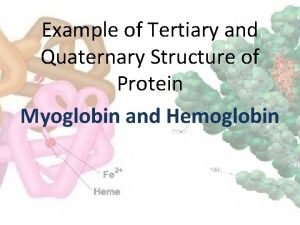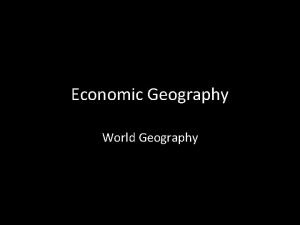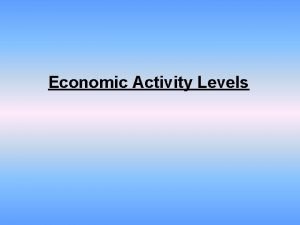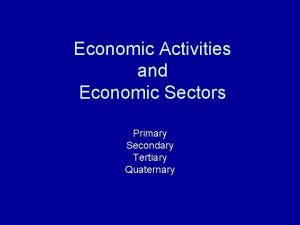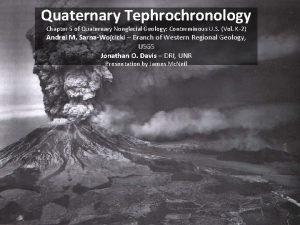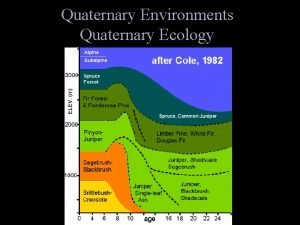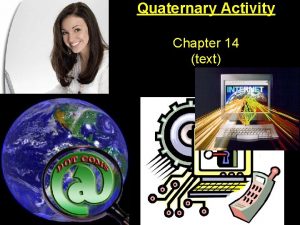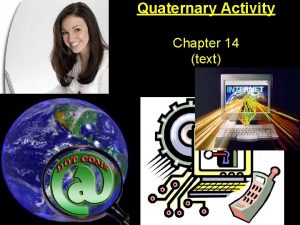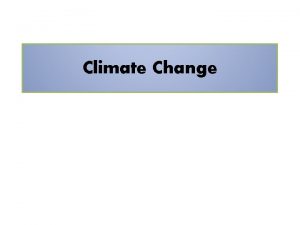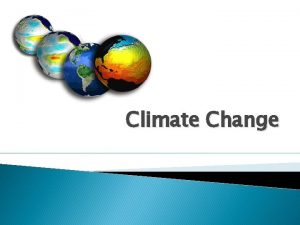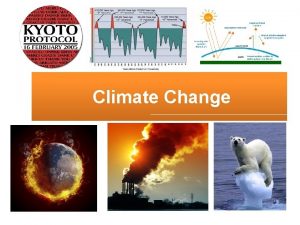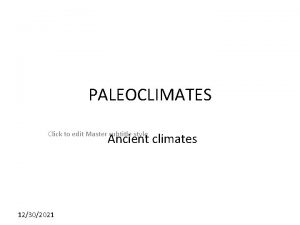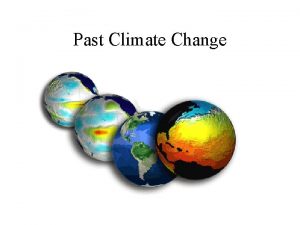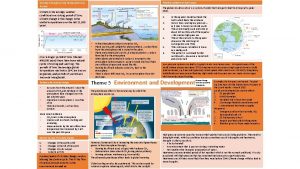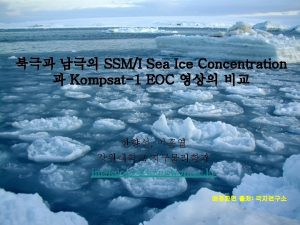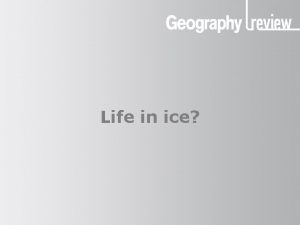Paleoclimates climate change in the Quaternary Ice Age























- Slides: 23

Paleoclimates – climate change in the Quaternary Ice Age

Getting started In this unit you will explore the climate of the current Ice Age, looking at how and why it has changed. You’ll need a notepad on which to make notes as you go along, or you could make notes, paste images, etc. on your device. You can view these slides: • as a slide-show for any animations and to follow links • in ‘normal’ view if you want to add call-outs or extra slides to make notes, paste images, answer questions. © Geographical Association, 2021

Ice Ages, glacials and interglacials There have been five known Ice Ages in Earth's history. Currently, we are in the Quaternary Ice Age, which started 2. 6 million years ago. • During Ice Ages, the environment fluctuates between phases of colder conditions, known as glacials, and warmer phases known as interglacials. • The Earth is currently in an interglacial phase of the Quaternary Ice Age termed the Holocene. • The last glacial phase of the Quaternary, when large ice sheets spread across much of Europe and North America, ended approximately 11, 700 years ago with the start of the Holocene. • There have been around 30– 50 glacial-interglacial cycles in the Quaternary. • All Quaternary glacial and interglacial phases except the Holocene © Geographical 2021 together and known as the Pleistocene. are Association, grouped

The Quaternary in perspective Activity Locate the following events on this timeline: • the age of the dinosaurs – the Mesozoic • the age of the trilobites – the Palaeozoic • earliest life appears around 3500 million years ago. © Geographical Association, 2021

Pleistocene glacials and interglacials in the UK Activity Watch the animation (look for the GIF) and download the Google Earth animation showing the extent of the ice sheet covering the British Isles through part of the Pleistocene. • When was the ice most extensive? • Does it correspond to the coldest temperatures on the graph to the left? © Geographical Association, 2021

Gathering data about past climates In order to understand how the climate has Activities changed in the past, we need weather • Explore this map and measurements from the time before text and make notes about the different instruments existed. sources of proxy climate data. For these purposes, we have to use climate • Watch this video and proxies, such as the information stored in check your ice cores (below) or bogs, tree rings and understanding using the shells. questions below the film. © Geographical Association, 2021

Forcing climate change: the Milankovitch Cycles The Earth’s orbit around the Sun changes in three ways through time because of the combined gravitational pull of the Sun, Saturn, Jupiter and other planets – these are known as the Milankovitch Cycles. They affect which regions of the Earth’s surface are closest to or facing the Sun at different times of year. The three cycles affect: • how circular or elliptical the Earth’s orbit around the Sun is • the angle of tilt of the Earth’s axis of rotation • where in space the Earth’s axis of rotation points (the precession of the axis). © Geographical Association, 2021

Earth and Sun Axial tilt: 23. 5º • The Earth orbits around the Sun once a year on an elliptical orbit. • The Earth also rotates around an (imaginary) axis through the North and South Poles. The Earth’s axis is tilted by 23. 5°: the axial tilt. • The Earth rotates round its axis every 24 hours. This explains day and night: it is daytime on the side of the Earth facing the Sun, night on Activity Watch this animation of Earth’s orbit and axis. Try and explain day and the side facing away. night and seasons to a member of your household using the animation or a globe/ ball and light/ torch. © Geographical Association, 2021

Changes to the Earth’s orbit Orbit: the Earth’s orbit is elliptical. The shape of this orbit changes slightly over 110, 000 years. • The Earth is currently closer to the Sun in January than in July, meaning that the seasons are more extreme in the Southern Hemisphere than in the Northern Hemisphere. The Northern Hemisphere receives about 7% less radiation in its summer, and 7% more in its winter than the Southern Hemisphere in its equivalent seasons. • With a more elliptical orbit, the Earth passes closer to the Sun than it ever does on a more circular orbit. • This can allow the melting of polar ice in the summer. With a more circular orbit, winter ice can survive the summer and grow in the following winter, triggering a glacial period. © Geographical Association, 2021 Activity Watch the first animation on this NASA page to check you can visualise changes in the Earth’s orbit.

Changes to the Earth’s tilt Axis tilt: Earth’s axis tilts; the angle of Activities • Watch the second tilt changes over 41, 000 years. • The tilt changes between 21. 1° and 24. 5°. It is currently 23. 5° and decreasing. • If the Earth’s axis were vertical, we wouldn’t have any seasons. • When the axis tilts more, summers are warmer and winters colder. When the axis tilts less, summers are cooler and winters are warmer. © Geographical Association, 2021 animation on this NASA page to check you can visualise changes in the Earth’s tilt. • Stretch your thinking: why might a smaller angle of tilt cause ice caps to grow?

Changes to the Earth’s rotation (precession) Axis rotation: Earth spins on its axis; this changes over 26, 000 years because of the pull of the Sun and moon on the Earth. • Over time the axis ‘wobbles’ and points to a different direction in space. • One way to visualise this is like a child’s spinning top wobbling as it slows down • It changes which star we see as the North Star – currently it is Polaris, but 13, 000 years ago, it would have been Vega. • When the North Pole points more © Geographical Association, 2021 Activity • Watch the third animation on this NASA page to check you can visualise changes in the Earth’s rotation. • Read this article and look for examples of Saharan rock art that record the changing climate.

Milankovitch Cycles: feedbacks and combinations Feedback mechanisms • If a polar region receives less sunlight, ice grows which in turn reflects more sunlight, cooling the Earth more • As oceans cool, they absorb greenhouse gases, cooling the climate more. Combinations • Water and land heat up and cool down differently: continental drift interacts with the Milankovitch Cycles • The three Milankovitch Cycles interact: at the Mid-Pleistocene Transition around 1. 2 million to 700, 000 years ago, the Milankovitch cycles started interacting differently, with a shift to a dominant 100, 000 year climate signal. © Geographical Association, 2021

Forcing climate change: the Sun • We get energy (light, ultraviolet light and heat) and charged particles from the Sun. • Charged particles give us the Northern and Southern lights and can have an impact on communications. • However, changes in the energy we get from the Sun have a greater impact on weather and climate. • The more sunspots there are on the surface of the Sun, the more energy arrives at the top of the atmosphere and heats the Earth’s surface. • The Sun may have introduced an overall global warming of approximately 0. 07°C before 1960. © Geographical Association, 2021 Activities Select Sun from the menu on this site. • Scroll down to the graph which shows ‘solar irradiance and sunspot number’. Solar irradiance is the amount of the Sun’s energy arriving at the top of the atmosphere. Describe how the two lines relate to each other. • Now scroll up to the graph which shows sunspot activity since 1700. When would you expect there to have been a warmer/ colder climate?

Forcing climate change: volcanoes • Huge explosive volcanic eruptions in the Tropics, energetic enough to push sulphur gases up into the relatively stable stratosphere where they condense into aerosols (small particles), can have a cooling effect on climate by increasing the albedo of the atmosphere. More of the Sun’s light is reflected by the aerosols before it reaches the ground. The climate cools. • The impact of a volcano is greatest in the summer (when there is more sunlight to be reflected) and over land (which heats up and cools down more quickly than ocean water). • Volcanoes can also emit greenhouse gases. © Geographical Association, 2021 Activities Have a look at this Power. Point then research the very different ways the following volcanoes affected the climate: • Eyjafjallajökull, 2010 • Tambora, 1815 • Yellowstone, 640, 000 years before present.

1816: the ‘year with no summer’ The combined eruptions of La Soufrière (1812), Mayon (1814) and Tambora (1815) had catastrophic global effects, leading to a ‘year with no summer’ in 1816. As a result: • in 1817, 11. 5% of Parisians were described as destitute • 65, 000 people starved to death in Ireland • in Switzerland, the death rate was 56% higher in 1817 than in 1815 • formula baby milk was invented • Turner painted vivid sunsets • Dracula and Frankenstein’s monster were created. © Geographical Association, 2021 Activities • Read this article and recreate figure 5, either with a screenshot, in Excel or on graph paper, leaving space for two more bars per month • Now use the Met Office website to look at the current climate at Tynemouth. Add current frost days and rainfall days to your figure. Where are the significant differences to 1816? • Does your graph support the conclusions in the article?

Carbon dioxide and temperature • Data from Antarctic ice, such as the Vostok ice core, show that CO 2 levels in the atmosphere and atmospheric temperatures fluctuate roughly together. • The initial changes in temperature during interglacial periods are explained by the Milankovitch Cycles. As ocean temperatures start to rise, the solubility of CO 2 in water decreases and so the oceans release CO 2 into the atmosphere. In turn, this release amplifies the warming trend, leading to yet more CO 2 being released. • Naturally, the increase in CO 2 lags © Geographical Association, 2021 behind the increase in temperatures. Activity Try this experiment or, if you have the equipment, this one.

The Little Ice Age (LIA) was a generally colder period between 1450 and 1850. Within the period, there were some isolated colder events, which occurred at different places at different times. In the Northern Hemisphere, temperatures were generally less than 1°C colder during the Little Ice Age than during the late 20 th century. © Geographical Association, 2021

Did the European conquest of the Americas contribute to the Little Ice Age? Read this article then reflect: Some people have argued that the drop in atmospheric CO 2 in 1610, only 18 years after Columbus landed, marks the start of the Anthropocene – the period during which human activity has been the dominant influence on the Earth’s geology, ecosystems and climate system. Other suggestions for when the Anthropocene started include: • Megafauna extinctions from 50, 000 to 10, 000 BC. Overhunting by humans made a significant contribution. • The beginning of farming around 11, 000 BC, or when it became widespread in 8, 000 BC. • The beginning of rice farming in 6, 500 BC. Rice farming releases methane, a greenhouse gas, into the atmosphere. • The beginning of evidence for human activity recorded in soils, 3000 to 500 BC. • The Industrial Revolution, 1760 AD. • Nuclear explosions: 1945 saw the first nuclear explosions; long-lived radioactive elements leave a dateable layer in soils. At much the same time the widespread use of mass-produced fertilisers, which impact on the nitrogen cycle, and of new plastics occurred. © Geographical 2021– What do. Association, you think is there such a thing as the Anthropocene? If so, when did it

Climate change in the UK The Central England Temperature dataset (CET) is the longest instrumental record of temperature in the world. • The data represents the temperature in a roughly triangular area enclosed by Lancashire, London and Bristol. • The sources of the data include records kept by individuals around the country. The precision of the data published for each year reflects the number, accuracy, reliability and geographical spread of the temperature records that were available for that year. • The mean monthly temperature record starts in 1659 with daily data being available from 1772. © Geographical Association, 2021 Reflection • The instrumental data used in creating the CET has been carefully combined and corrected. • Have a look at the TEMPEST database. What are the uses and limitations of written accounts such as these?

Glossary 1 • Aerosol: A suspension of airborne solid or liquid particles, with a typical size between a few nanometres and 10μm that reside in the atmosphere for at least several hours. • Albedo: The fraction of solar radiation reflected by a surface or object. Snow-covered surfaces have a high albedo, the albedo of soils ranges from high to low, and vegetation-covered surfaces and oceans have a low albedo. • Anthropocene: The period during which human activity has been the dominant influence on the Earth’s geology, ecosystems and climate system. • Climate feedbacks: An interaction in which a perturbation (change) in one climate quantity causes a change in a second, and the change in the second quantity ultimately leads to an additional change in the first. A negative feedback is one in which the initial perturbation is weakened by the changes it causes; a positive feedback is one in which the initial perturbation is increased. • Climate forcings: Forcing represents any external factor that influences global climate by heating or cooling the planet. They may be either natural or anthropogenic (caused by humans). • Climate proxies: Climate proxies are preserved physical characteristics of © Geographical Association, 2021

Glossary 2 • Glacial: A colder period within an Ice Age, when glaciers and ice sheets grow. • Ice Age: A period of time when there is widespread glaciation and permanent ice at the poles. • Interglacials: Periods with a warmer climate in between glacials. • Precession: Precession is a change in the orientation of the rotational axis of a rotating body. • Sunspots: Sunspots are temporary phenomena on the Sun's photosphere that appear as spots darker than the surrounding areas on the surface of the Sun. • Stratosphere: The highly stratified (layered) region of the atmosphere above the troposphere extending from about 10 km (ranging from 9 km at high latitudes to 16 km in the Tropics on average) to about 50 km altitude. © Geographical Association, 2021

Links From the awarding bodies Topic AQA 3. 1. 4 Glacial systems and landscapes Eduqas 1. 2. 2 Glaciated landscapes: causes of climate change Edexcel 2 a Climate change and glaciated landscapes OCR 3. 1 Climate change WJEC 1. 2. 2 Glaciated landscapes: causes of climate change CCEA D 1: Natural climate change processes © Geographical Association, 2021 Further reading • Metlink notes: past climate change • Skeptical Science: Climate change myths • From the GA: ▫ The Anthropocene: a primer for geographers ▫ GEO: Reading around climate change ▫ Knight, S. (2019) ‘Did the European conquest of the Americas contribute to the Little Ice Age? ’ Teaching Geography, 44, 2, pp. 6871. • The Little Ice Age, How Climate made History, 1300 -1850, B. Fagan, Basic Books, (2000) • The Two-Mile Time Machine: Ice Cores, Abrupt Climate Change, and Our Future Richard B. Alley, Princeton University Press, (2002)

Acknowledgements This presentation has been written by Dr Sylvia Knight, Head of Education at the Royal Meteorological Society Figures • Slide 4: https: //www. metlink. org/resource/6 -past-climate-change/ • Slide 5 https: //www. metlink. org/resource/past-climate-changes-module-1/ • Slide 6 National Science Foundation Ice Core Facility used with permission • Slide 12: Image: © By Dragons flight (Robert A. Rohde) CC-BY-SA-3. 0, via Wikimedia Commons: https: //commons. wikimedia. org/wiki/File: Five_Myr_Climate_Change. png • Slide 13 https: //soho. nascom. nasa. gov/home. html • Slide 16: Graph source https: //commons. wikimedia. org/wiki/File: Co 2 -temperaturerecords. svg Leland Mc. Innes under the Creative Commons Attribution-Share Alike 3. 0 Unported • Slide 17: source of image: Henrik Avercamp / Wikimedia Commons https: //en. wikipedia. org/wiki/File: Hendrick_Avercamp__Winterlandschap_met_ijsvermaak. jpg © Geographical Association, 2021
 Climate change 2014 mitigation of climate change
Climate change 2014 mitigation of climate change Stone age, bronze age iron age timeline
Stone age, bronze age iron age timeline Iron age bronze age stone age timeline
Iron age bronze age stone age timeline The three kinds of temperate marine climates all have
The three kinds of temperate marine climates all have Clear ice vs rime ice
Clear ice vs rime ice Clear ice vs rime ice
Clear ice vs rime ice 5 major ice ages
5 major ice ages When did the last ice age start and end
When did the last ice age start and end Ice age sheep
Ice age sheep Liz ive age
Liz ive age Seafloor spreading demonstration
Seafloor spreading demonstration Ice age migration
Ice age migration Last ice age
Last ice age Secondary geography definition
Secondary geography definition Secondary and tertiary structure
Secondary and tertiary structure What is a tertiary consumer
What is a tertiary consumer Advantage of quaternary
Advantage of quaternary Tertiary age
Tertiary age Quaternary consumer
Quaternary consumer Primary structure of protein ppt
Primary structure of protein ppt Quaternary economic activity
Quaternary economic activity 4 levels of economic activity examples
4 levels of economic activity examples What are quaternary economic activities
What are quaternary economic activities What are quaternary consumers
What are quaternary consumers



